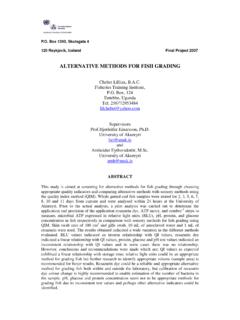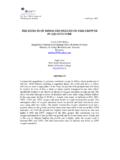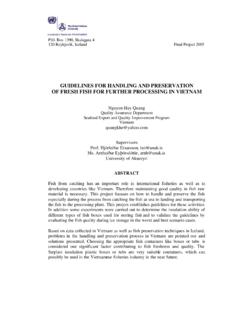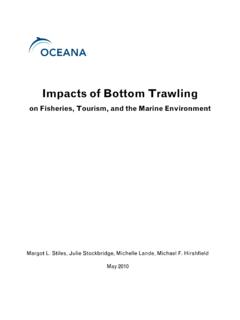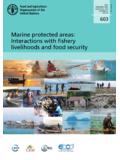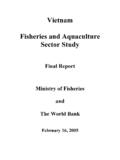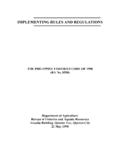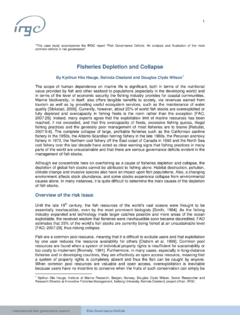Transcription of PRE- AND POST-HARVEST HANDLING AND …
1 Box 1390, Skulagata 4 120 Reykjavik, Iceland Final Project 2007 PRE- AND POST-HARVEST HANDLING AND PROCESSING PROCEDURES FOR THE PRODUCTION OF SAFE AND HIGH QUALITY FRESH fisheries PRODUCTS IN BANGLADESH Hasan Ahmmed Department of fisheries 11th Floor, Matsya Bhaban, Dhaka-1000 Bangladesh. Supervisors Prof. Hjorleifur Einarsson Arnheidur Eythorsdottir University of Akureyri ABSTRACT fisheries play a significant role in Bangladesh providing 63% of the animal protein supply and 10% direct or indirect employment for 150 million people, and are the second highest export earning source of the country. The fish processing sector has not achieved expected export returns with respect to the growth rate of aquaculture and overall fish production. Lack of technical production knowledge on high quality and safe products prevents proper utilisation of the available carp and catfish from aquaculture.
2 To improve fish processing in Bangladesh, the limitations of current practices were studied in comparison to processing practices in Iceland. Long, complicated fish supply chains, shortage of technical skills, and weak safety and quality management systems were identified as the major obstacles in the Bangladesh fish processing industry. Based on information gained in Iceland, a comprehensive HANDLING , processing and quality management system has been suggested for Bangladesh and a set of recommendations made to implement this practice. Key words: HANDLING , processing, quality, safety, carp, catfish Ahmmed 2 UNU- fisheries Training Programme TABLE OF CONTENTS 1 INTRODUCTION .. 5 Global fisheries overview .. 5 World fisheries production 5 Utilisation of fisheries production .. 6 World fish trade and export-import .. 6 Changing demands of consumers, quality and food safety issues.
3 7 Icelandic fisheries .. 7 Bangladesh fisheries overview .. 7 Bangladesh: general situation .. 7 Bangladesh fisheries resources .. 8 Bangladesh fishery production .. 10 Export trends of fishery products .. 11 fisheries export commodity .. 12 Processing industry sector in Bangladesh .. 12 Existing problems of processing industry .. 12 Marketing of fish and shrimps .. 13 Justification .. 14 Goal and objectives .. 15 2 MATERIALS AND METHODS .. 15 Information collection .. 15 Visiting the Icelandic fish processing industry .. 16 Documentation of suggested practice for Bangladesh .. 16 3 RESULTS .. 16 Food safety regulations .. 16 Food safety regulation of Bangladesh (FIQC Ordinance, 1983, amend. 1997) .. 16 General aspects of food regulations .. 17 General Food Law .. 18 Food business operator s obligations .. 18 What is a food business? .. 19 Registration and 19 General 19 Hygiene requirements.
4 20 Food safety management system (HACCP) .. 20 Training .. 20 Traceability .. 21 Notifications .. 21 Fish and fish processing in Bangladesh .. 21 Important fish species .. 21 Feeding habit and growth of carp and catfish .. 22 Chemical composition of carp and catfish .. 22 Fish supply chain in Bangladesh .. 22 Current fish processing practice in Bangladesh .. 25 Quality control and food safety .. 26 Hazard factors involved in production steps .. 26 Limitations of existing POST-HARVEST HANDLING and processing practices .. 28 Ahmmed 3 UNU- fisheries Training Programme Fish HANDLING and processing practice in Iceland .. 28 Production planning for processing of fish and fisheries products .. 28 Onboard HANDLING of marine catch .. 29 Processing techniques .. 29 Quality monitoring and control .. 33 Traceability .. 33 4 SUGGESTED PRACTICE FOR BANGLADESH .. 34 Production planning for HANDLING and processing of fresh fish.
5 34 Generic HANDLING steps of fresh fish .. 34 Harvesting .. 34 HANDLING of aquaculture farmed fishes .. 35 Icing or cooling of fishes .. 36 Container of fish .. 37 Generic processing steps of fresh fish .. 37 Receiving of fish raw materials .. 37 Information regarding raw materials .. 37 Quality checking of fish raw materials before processing .. 37 Grading of fish raw 38 Processing of fresh fish .. 39 Safety and quality control .. 41 5 DISCUSSION RECOMMENDATIONS AND CONCLUSION .. 41 General discussions .. 41 Recommendations for 44 Introduce good HANDLING of fish .. 44 Improve processing of fresh 44 Food safety and quality assurance programme .. 44 Conclusion .. 46 LIST OF REFERENCES .. 48 Appendix 2: Total quality management (TQM) Handbook of an Icelandic Fish Processing Industry.. 51 Ahmmed 4 UNU- fisheries Training Programme LIST OF FIGURES Figure 1: Global fisheries production (1996-2005) capture and aquaculture, fish and other animals.
6 5 Figure 2: Utilisation of world fisheries supply in 1983 and 1992-2004 (FAO 2006c).. 6 Figure 3: Resource wise fisheries production of Bangladesh from 1997-2006 (DoF 2006).. 10 Figure 4: Catch composition of the total fisheries production of Bangladesh (DoF 2006).. 11 Figure 5: Catch composition of the fresh water fisheries production of Bangladesh (DoF 2006).. 11 Figure 6: Shrimp and fish export trends of Bangladesh from 1993 to 2006 (DoF 2006).. 11 Figure 7: Fish supply chain from producer level to processing plant or consumers in Bangladesh.. 25 Figure 8: Processing flow-charts for production of fresh and frozen products from Icelandic fish species (cod, haddock, Pollock, ocean perch).. 31 Figure 9: Processing flow-charts for production of fresh and frozen products from Bangladesh fish species (carp and catfish).. 40 LIST OF TABLES Table 1: Annual total catch and area productivity by fisheries resources of Bangladesh (DoF 2006).
7 9 Table 2: Chemical composition of some important fresh water carps and catfish of Bangladesh (Chakraborty et al. 2003) .. 23 Ahmmed 5 UNU- fisheries Training Programme 1 INTRODUCTION Global fisheries overview fisheries play an important role in many countries contributing to livelihood, food security and trade as well broad aspects of national economies. In developing countries, fisheries resources management and aquaculture are considered to be the most effective tools for poverty eradication through employment and income generation, increased nutrition and livelihood improvement. During the last three decades, involvement of fisheries in the global food production for domestic use has increased considerably. This progress has been achieved through the development of aquaculture. Beside this development, some issues have been raised regarding the global distribution, utilisation and trade of the fisheries resources as well as quality, safety and future sustainability.
8 World fisheries production trends World fish production increased from 40 million tonnes in the early 1960s to nearly 142 million tonnes (t) in recent years (FAO 2006a). During the last decade, this increase is mostly from growing aquaculture production amounting to 48 million t along with the stable catch of capture fisheries , about 94 million t (Figure 1). World aquaculture production increased from 27 million t in 1995 to 48 million t in 2005, of which million t were produced in Asia, million t in Europe, million t in North and South America and the remaining parts in Africa and Oceania. The expansion of aquaculture is mainly due to an increase in carp and shellfish culture practices in developing countries during the last 20 years. The algae production has also increased considerably to about 15 million t where brown algae is million t, red algae million t and other aquatic plants 3 million t (FAO 2006b).
9 9393869395969693989727293134353840434648 0204060801001201401601996199719981999200 020012002200320042005million metric tonsaquaculturecaptureSource: FAO FishStatplu Figure 1: Global fisheries production (1996-2005) capture and aquaculture, fish and other animals. During the last 10 years, a considerable increase has been observed regarding aquaculture production and exports in some South Asian countries such as China, India, Thailand, Philippines, Vietnam and Indonesia. Among the aquaculture producing countries, China contributes a major share of the world aquaculture production in both finfish and shellfishes. In 2004, the aquaculture production of Ahmmed 6 UNU- fisheries Training Programme China was million t where carps were million t, which were about 70% and 65% of the world aquaculture and carp production respectively (FAO 2006b). Following China, other top ranking aquaculture producing countries are India ( ), Philippines ( ), Vietnam ( ), Indonesia ( ), Thailand ( ), Bangladesh ( ) and Japan ( ).
10 Utilisation of fisheries production Out of 148 million t world total production, about 105 million t of fish went for human consumption in 2005. Figure 2 shows the utilisation trends of the fisheries production since 1983 and from 1993-2005. Fish has a significant capacity for processing to produce diversified value added products and almost two third of the catch were used for further processing and marketing in 1998 (FAO 2000). During 1960 to 2000, between 20 and 30% of the total world fish production had been used for manufacturing animal feed (FAO 2000). At that period, a large portion, approximately 30%, of fish used for human consumption was frozen fish, 14% was canned, 12% cured and the remaining 45% were sold fresh. A significant growth of fresh fish consumption was observed during the 1990s (FAO 2002) and the trend has continued with an increasing utilisation rate of fresh fish for human consumption since 1994.
